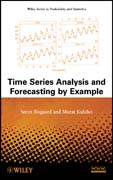
ÍNDICE: Chapter 1. Time Series Data: Examples and Basic Concepts. 1.1 Introduction. 1.2 Examples of time series data. 1.3 Understanding autocorrelation. 1.4 The Wold decomposition. 1.5 The impulse response function. 1.6 Superposition principle. 1.7 Parsimonious models. Chapter 2. Visualizing Time Series DataStructures: Graphical Tools. 2.1 Introduction. 2.2 Graphical Analysis of TimeSeries. 2.3 Graph terminology. 2.4 Graphical perception. 2.5 Principles of graph construction. 2.6 Aspect Ratio. 2.7 Time Series Plots. 2.8 Bad Graphics. Chapter 3. Stationary Models. 3.1 Basics of Stationary Time Series Models. 3.2 Autoregressive Moving Average (ARMA) models. 3.3 Stationary and Invertibility of ARMA models. 3.4 Checking for stability using variogram. 3.5 Transformationof data. Chapter 4. Nonstationary models. 4.1 Introduction. 4.2 Detecting nonstationarity. 4.3 Autoregressive Integrated Moving Average (ARIMA) models. 4.4Forecasting using ARIMA models. 4.5 Example 2: Concentration Measures from a Chemical Process. 4.6 The EWMA forecast. Chapter 5. Seasonal Models. 5.1 Seasonal Data. 5.2 SEASONAL ARIMA MODELS. 5.3 Forecasting using Seasonal ARIMA models. 5.4 Example 2: Company Xs Sales Data. Chapter 6. Time Series Model Selection. 6.1 Introduction. 6.2 Finding the Best Model. 6.3 Example: Internet Users Data. 6.4 Model Selection Criteria. 6.5 Impulse Response Function to study thedifferences in models. 6.6 Comparing Impulse response functions for competingmodels. 6.7 ARIMA models as rational approximations. 6.8 AR vs. ARMA Controversy. 6.9 Final Thoughts on model selection. Chapter 7. Additional Issues in ARIMA models. 7.1 Introduction. 7.2 Linear difference equations. 7.3 Eventual forecast function. 7.4 Deterministic trend models. 7.5 Yet another argument for differencing. 7.6 Constant term in ARIMA models. 7.7 Cancellation of terms in ARIMA models. 7.8 Stochastic trend: unit root nonstationary processes. 7.9 Overdifferencing and Underdifferencing. 7.10 Missing values in time series data. Chapter 8. Transfer Function Models. 8.1 Introduction. 8.2 Studying input-output relationships. 8.3 Example 1: Box-Jenkins Gas Furnace. 8.4 Spurious cross correlations. 8.5 Prewhitening. 8.6 Identification of the transfer function. 8.7 Modeling the noise. 8.8 The general methodology for transfer function models. 8.9 Forecasting using transfer-noise models. 8.10 Intervention Analysis. Chapter 9. Additional Topics. 9.1 Spurious relationships. 9.2 Autocorrelation in Regression. 9.3 Process Regime Changes. 9.4 Analysis of multiple time series. 9.5 Structural Analysis of Multiple Time Series. Bibliography. Appendix A. Data Sets for Examples. Appendix B. Data Sets for Exercises.
- ISBN: 978-0-470-54064-0
- Editorial: John Wiley & Sons
- Encuadernacion: Cartoné
- Páginas: 392
- Fecha Publicación: 01/07/2011
- Nº Volúmenes: 1
- Idioma: Inglés
